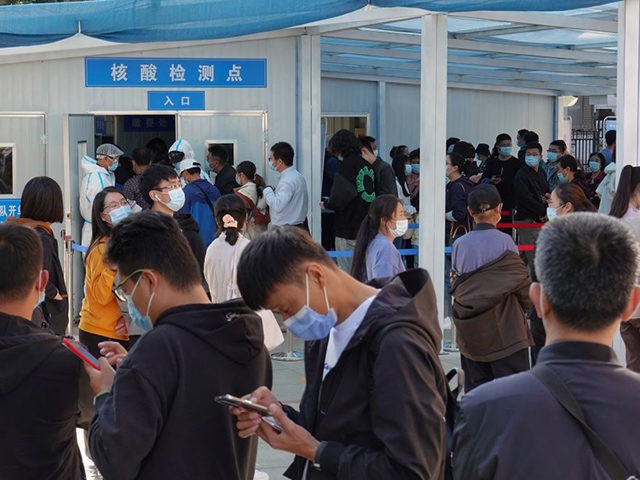Chinese officials announced on Monday that officials will test all nine million residents of the eastern city of Qingdao for the Wuhan coronavirus after confirming 12 new infections there.
“Mass testing was launched on Sunday evening after reports of the new cases were confirmed. By Sunday night, photos were circulating online showing residents lining up for tests,” the Hindustan Times reported.
Local officials said there have been six confirmed local transmissions of the coronavirus and six asymptomatic individuals who tested positive, all of them connected to the Qingdao Chest Hospital, described by the Hindustan Times as a treatment center for “imported” coronavirus cases, including foreign tourists and Chinese who have traveled abroad.
China’s state-run Global Times blamed the outbreak on heavy tourism traffic during National Day, the holiday that commemorates the founding of the Communist People’s Republic of China:
The outbreak in Qingdao has a certain risk of spreading, public health experts reached by the Global Times warned, as a large number of tourists had been to the tourist city during the holidays, but the scope of spread should be limited and confined to people who had connection with the Qingdao Chest Hospital.
Data from the Qingdao Bureau of Culture and Tourism showed that the city received 4.47 million passenger trips during the National Day and Mid-Autumn Festival holidays. During the eight-day holiday, the average occupancy rate of 67 star-rated hotels in Qingdao reached 39.07 percent, and 93 A-level scenic spots received 2,827,300 tourists.
Some local residents reached by the Global Times said the hospital where the infected patients were discovered is far from the city center and tourist sites, and tourists would not usually go there. They said people who have travelled to Qingdao should not be too worried about the risk of infection.
The Global Times reported that several other cities, including Beijing, have “required residents who had been to Qingdao during the holidays to report to their local communities” for testing.
“Days before the holidays, on September 24, Qingdao found two cases of asymptomatic infection during routine tests on workers processing imported cold chain products. When Qingdao tried to contain the asymptomatic infections, authorities assured the public that local tourism would not be affected,” the report noted.
Sky News quoted Qingdao officials who said the entire city population would be tested within a week, with testing stations open until 11 p.m. to handle the large number of patients. Similar mass testing programs have been carried out in Beijing and Wuhan, the city from which the global coronavirus pandemic originated.
“While the daily new-case counts in the U.S. and Europe are in the tens of thousands, China’s are in the low two digits, and almost all the infections are brought in by people traveling from other countries. New arrivals who test positive are immediately placed in strictly enforced quarantine. Those efforts have helped China’s economy bounce back faster than those of major competitors, and officials are eager to prevent a second wave of infections that could derail the recovery,” the Wall Street Journal explained.
The Wall Street Journal described Qingdao as famed for its “beaches and beer,” as it is home to one of China’s most famous breweries. The city held a three-week beer festival in August without any reported coronavirus infections. According to Chinese officials, Qingdao has only logged a grand total of 65 coronavirus infections throughout the pandemic, with only one fatality.
The Communist Party of China, through its state media arms, actively promoted tourism during the national holiday as a way to boost the economy.
“The country’s tourism industry is more than thrilled to see what they believe could be the ‘busiest ever’ holiday season since the COVID-19 outbreak, as travelers in the world’s largest outbound-travel source market all flocked back and may further empower China’s consumption and economic rebound in the post-epidemic era,” the Global Times asserted in late September, celebrating the widespread travel. The outlet published photos of happy tourists flocking to crowded sites for selfies and shopping.
While the Global Times predicted a spending boom during the holiday, over 100 million fewer people traveled during this year’s Golden Week that 2019, one of the most sluggish figures in recent memory.
“The data is worrying because golden week this year was meant to show a strong recovery in spending,” the South China Morning Post noted in its economic analysis. “The big picture is that Chinese consumer spending remains weak. How to boost that will be a top priority for policymakers when they gather later this month to map out the country’s strategies for the next five years.”

COMMENTS
Please let us know if you're having issues with commenting.